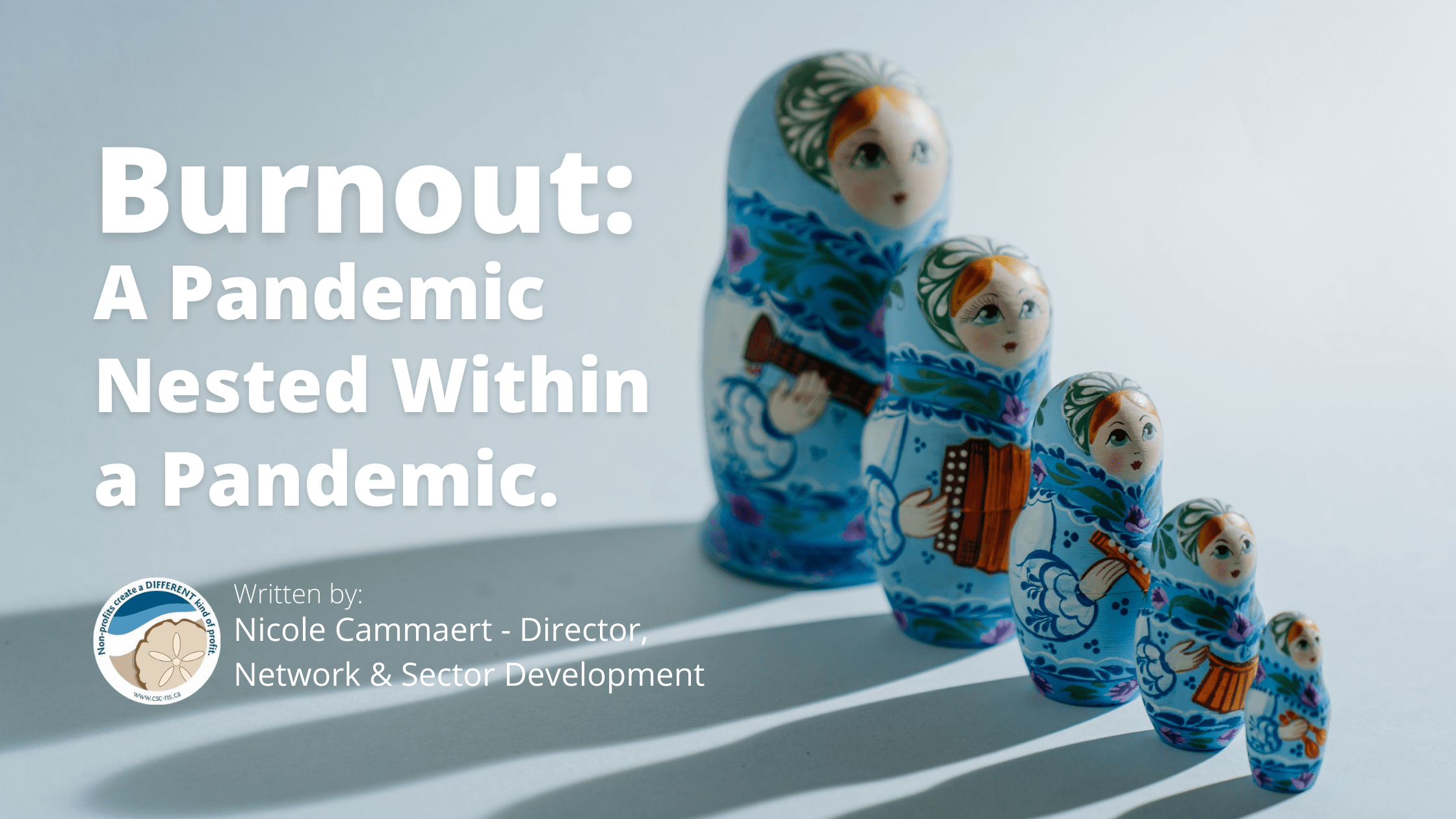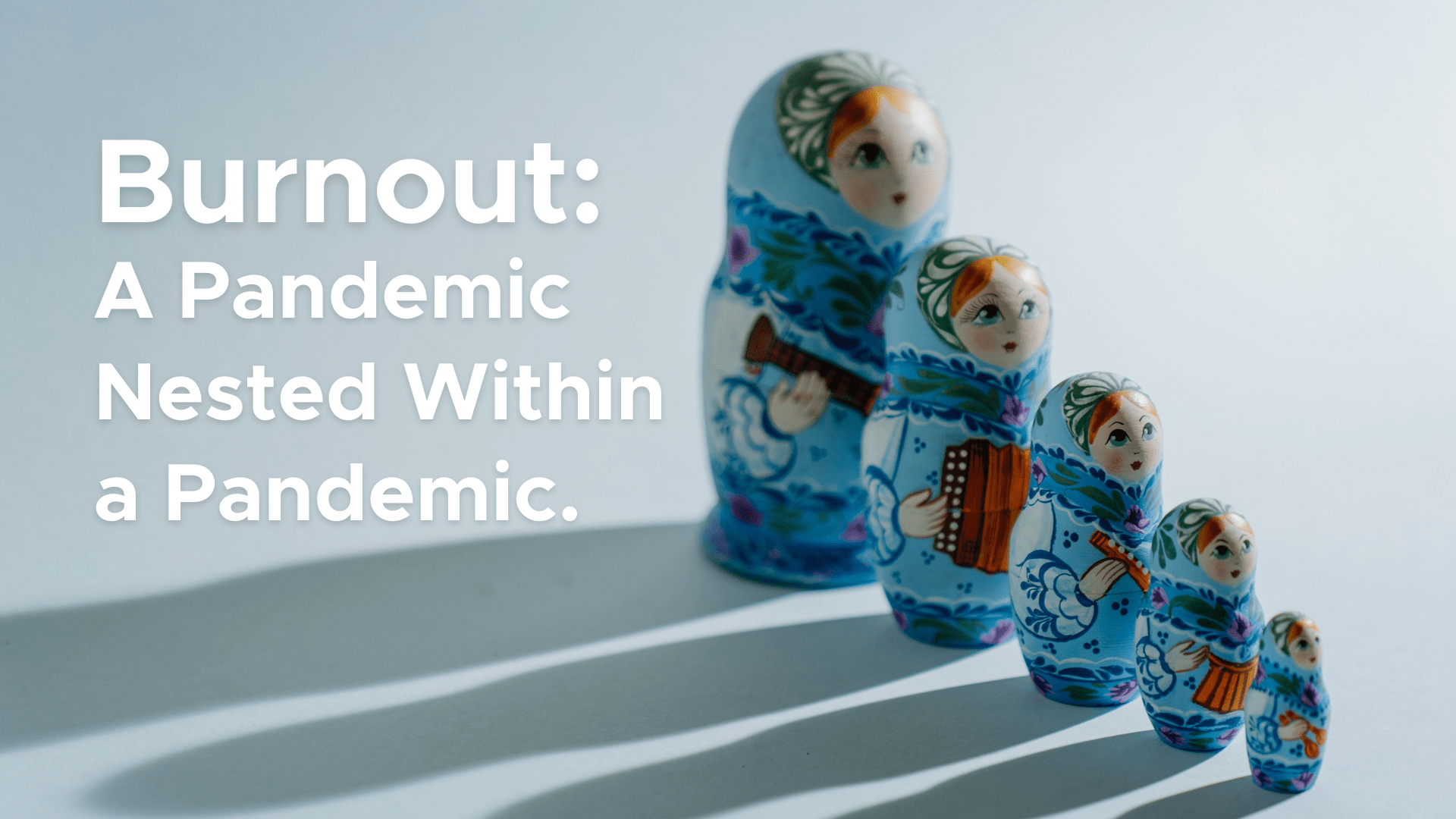
Burnout: A Pandemic Nested in a Pandemic
Written by Nicole Cammaert, Director Network & Sector Engagement
As I was reading articles on burnout one evening (yes, I hear the irony!), I overhead my daughter and her friend talking about how nervous they were for their upcoming Grade 12 Global Geography test. One jokingly said to the other, “When in doubt, answer ‘Carrying Capacity.'” I thought of this in relation to the planet; how the Earth has the wisdom to implement the right forces to come back toward homeostasis and how our bodies also seek to come into balance when we are beyond our carrying capacities. I wonder – if individuals and organizations were to apply the spirit of that principle to ourselves, could we honour our own capacity and create a healthier, more vibrant sector and society?
The COVID-19 global pandemic has shone a light on many of our problematic systems of capitalism, systemic racism, and uneven distribution of wealth and power. It has also offered a portal for a new way of being with ourselves and others, as well as the opportunity to take a collective breath and re-discover what’s most important to us.
When I think of complexity and interconnectedness and systems thinking, I imagine a set of Babushka dolls where one doll fits or is nested within the other. In systems change work, we think of how all levels of the system are interconnected, beginning with self and extending outwards and upwards to our organizations, our sector, and larger society. This holds true for the rampant issue of burnout in the nonprofit sector and its impact on each level of the system.
We’ve long known that burnout is rampant in the nonprofit/for-impact sector, but due to rising costs, cuts in budgets, lean resources and staff – it feels like a mountain too high to climb. People in this sector, myself included on occasion, might joke (with a layer of cynicism) about how burned out we are. Others may boast about how busy they are, as though being busy is a badge of honour. Alternatively, sympathetic looks are exchanged – a shorthand for a deep understanding of the debilitating experience of burnout. But the reality is, burnout is literally killing us!
I recently took a listen to Brene Brown’s podcast where she interviewed Emily and Amelia Nagoski, authors of “Burnout, The Secret to Unlocking the Stress Cycle.” As one who really loves the metaphor of Babushka Dolls, I was incredibly interested in how burnout and stress affect the various systems within our bodies. Listening to this podcast will make you reflect on how devastating burnout is on our physical, emotional, mental, and spiritual health. The authors assert that we need a mindset shift from understanding what stress and burnout do physiologically to behaviour changes that bring about balance. I would add that a profound shift in mindset needs to occur in how we “organize” our organizations so that we are people-first. The belief being that when we take care of our people, the result is great work and great impact, not burnout.
In our first COVID-19 survey of the sector last year, the top responses to how people were feeling two-weeks into the pandemic were anxious, overwhelmed, concerned and worried. In a follow-up survey eight months later, the key insight from the report was that workplace stress and anxiety need consideration. We know this to be true about our sector here in Nova Scotia as burnout has become “An epic and rapidly evolving workplace phenomenon” (Harvard Business Review). Indeed, the burnout at the individual, organizational and systems level has become a such a widespread issue that the World Health Organization (WHO) included it in their International Classification of Diseases diagnostic manual. What is further remarkable, and feels promising, is that the WHO’s definition of Burnout has recently been updated to be defined as “A syndrome conceptualized as resulting from chronic workplace stress that has not been successfully managed.” This has led to further research about understanding the root causes of burnout and has helped reduce the stigma often associated with it.
Common myths that organizations tell themselves is that if an employee is burned out there must be something wrong with them. They can’t handle the pressure. They’re not smart enough. They can’t handle the pace or the workload. Or maybe, they’re just not resilient enough. Further, we’ve been told that the way to fix burnout is at the individual level. Do more yoga and meditation. Find better work/life balance or get counselling. Further exacerbating these outdated understandings of burnout is the reality that many nonprofits simply do not have access supports such as health plans, Employee and Family Assistance plans, or short-term or long-term disability plans.
The good news is that with research, we have a better understanding about what causes burnout, how to recognize it in ourselves, and how to address it. In the Harvard Business Review article “Burnout is About Your Workplace, Not Your People,” the author states that the responsibility for addressing burnout rests not with the individual, but with the organization saying, “Leaders take note: It’s now on you to build a burnout strategy.” (Jennifer Moss, December 11, 2019). As managers and leaders, how do we recognize burnout in our organizations and, within ourselves? Moss identifies the top 6 reasons people burnout as:
- Workload – too much/not enough resources
- Control – micromanagement, accountability without power, lack of influence
- Reward – not enough pay, acknowledgement or satisfaction
- Community – isolation, conflict, disrespect
- Fairness – Discrimination and favouritism
- Values – ethical conflicts, meaningless tasks
It is up to all of us to surface the paralyzing effects of burnout, first and foremost on our people – but also on our ability as organizations to deliver on our organization’s mission and to provide for the communities we are serving. We need to be talking about this at all system levels and seek to understand the interconnectedness throughout.
As I wrap-up this blog post, I’m reminded of a conversation that Otto Scharmer, Senior Lecturer in the MIT Management Sloan School and co-founder of the Presencing Institute, will often reference. When asking Bill O’Brien, CEO of Hanover Insurance, what his most important learning was in leading profound change, O’Brien replied, “The success of an intervention depends on the interior condition of the intervenor.” I thought of this advice on a recent snowshoe hike with my husband in the stunning Clyburn Valley in the Cape Breton Highlands National Park.
It takes some effort to plan a getaway, particularly in the winter. I found myself on a bit of hamster wheel in my mind, even on this glorious and peaceful hike. I was thinking – we need to get out before sundown… Did we pack the brie? What if we bump into a bear? And then I sat down at the edge of the river. The sun was beginning to lower in the pure blue sky, the wind was non-existent, the reflection of the trees was on the still water, and a few birds were sounding in the distance. I noticed the sound of gently flowing water against the frozen bits on the shore and the tracks of an otter on the riverbank beside me, imagining how fun it was for her to slide down into the cool, clear river. An adolescent eagle flew high above as I tracked the steps of a moose crossing the river to the wooded glades on the other side. We sat in gratitude for nature that surrounded us and I felt a sense of awe at how perfect it all was – in balance and harmony. Then my snow pants met the limitation of their water resiliency and I knew it was time to go! I walked out of those woods with such deep gladness and this blog wrote itself with each step.
Lao Tzu wisely says, “Nature does not hurry, yet everything is accomplished.” As much as we are a part of each level of the system, we too are a system. When we take care of ourselves, rest when we need to, and meet our own carrying capacity with awareness and kindness, things have a tendency to move toward an ebb and flow type of balance, and our thoughts and actions flow with more ease and grace. By organizationally slowing down – moving at the speed of trust – and implementing wise actions along the way, not only can we address burnout, but we can, in the long run, do more – both as individuals and as organizations.
In response to this growing pandemic of burnout, we are offering a Burnout Resiliency series to learn more about causes of burnout, how to recognize it in ourselves and on our teams, and what we can do about it. The first stream, designed for Executive Directors, filled almost immediately, which speaks to the prevalence of the issue and the desire to learn more about how to approach it in effective ways. A second stream open to all sector members will run later in April/May. Registration for this series will open shortly!

Nicole Cammaert
Director of Network and Sector Development
Further resources:
-
Beyond Burned Out: https://hbr.org/2021/02/beyond-burned-out
-
Do You Know Burnout When You See It? https://hbr.org/2021/01/do-you-know-burnout-when-you-see-it?registration=success
-
Burnout Is About Your Workplace, Not Your People: https://hbr.org/2019/12/burnout-is-about-your-workplace-not-your-people
-
Preventing Burnout is About Empathetic Leadership: https://hbr.org/2020/09/preventing-burnout-is-about-empathetic-leadership
-
Burnout From An Organizational Perspective: https://ssir.org/articles/entry/burnout_from_an_organizational_perspective#
-
Reversing Burnout: https://ssir.org/articles/entry/reversing_burnout
-
Burnout: How Nonprofit Leaders Can Better Support Their Staff: https://charityvillage.com/burnout-how-nonprofit-leaders-can-better-support-their-staff/
-
Self-Leadership – Create Balance and Stop the Glorification of Busy - https://pillarnonprofit.ca/self-leadership-create-balance-and-stop-glorification-busy-2021
-
Burnout: The Secret to Unlocking the Stress Cycle – https://www.chapters.indigo.ca/en-ca/books/burnout-the-secret-to-unlocking/9781984817068-item.html

Loved this. Nailed it. Great timing !
I now know as a burnout E.D it is time for me to begin to take care of me. The more I did outside my direct job description the more was requested/coerce.
Thank you
Nicely said! I have never before so strongly felt the need to hit a stop button. An extended pause, a time to re-set, is so needed by so many employees at this particular time in history. The pandemic has revealed and taught us much about new ways to work, a better work-life balance, but I fear few organizations will take the steps to re-organize work as they are confident in “normal” returning. We have the opportunity for change, for a better-than-normal, post-pandemic world of work. Missing or ignoring the opportunity will reveal a blind-spot in some organizations.
Great article Nicole! And a wonderful list of resources. Too often we don’t recognize burnout and instead focus on the negative behaviors and the poor performance. I appreciate your comment about celebrating long hours as an achievement and an indicator of a great employee. The nonprofit sector is full of hard working, resilient people but we all have a limit. Rather than addressing the problem, we can become critical of the employee or the ED. Performance appraisals (formal, or even more likely informal) that were once glowing turn sour. Often this can lead to a breakdown in communication as we avoid the conversation in hopes that the person will figure it out. Instead we need to connect more often and talk about realistic work that can be done with the existing resources, how leadership can be shared and distributed to others, and show gratitude for work that has been accomplished. Very excited to hear that the first Burnout Resiliency series is off to a good start!
Great post and the additional links are very helpful.